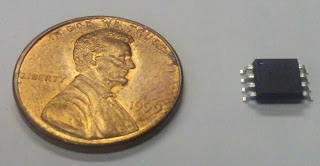There are many different packages that 1-wire devices are available in, from standard TO-92 and SOIC packages to i-button devices. No matter the package they come in they can all be accessed through the same 1-wire adapters (some hardware hacking required) because they all use the same 1-wire protocol. Here are some examples of the devices I have encountered.
 |
| DS2433 4kb EEPROM in a TO-92 package |
 |
| DS1904 iButton |
 | |
| DS2433 4kb EEPROM in a SOIC package |
I started with a standard off the shelf DS9490B USB adapter
Removed the cap and iButton and soldered two wires to the internal contacts of the iButton reader, one to the large copper contact on the board for the data line and one to the large ground shield that holds the button in place.
I then added some alligator clips to the wires. In the future I think some smaller ones would be easier to use, but I had these lying around so they will do for now.
Next post we will put our newly hacked device to use...



Casino Wyndham St. Charles - Mapyro
ReplyDeleteFind the perfect casino Wyndham St. 아산 출장마사지 Charles in 김포 출장안마 St. Charles, 군포 출장샵 MO with a map. and 성남 출장마사지 other 경상남도 출장샵 Casinos in this area.